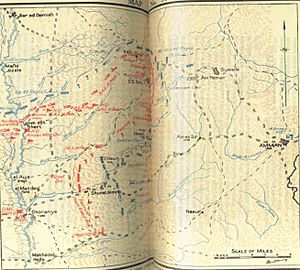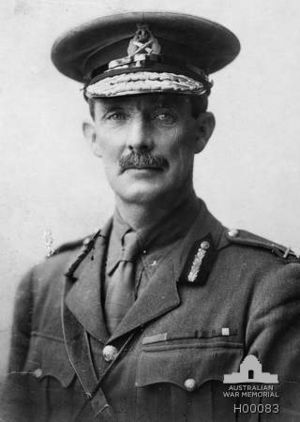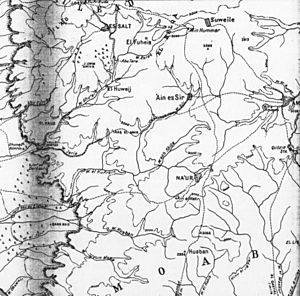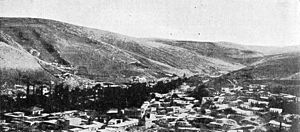Second Battle of Amman facts for kids
Quick facts for kids Second Battle of Amman |
|||||||
|---|---|---|---|---|---|---|---|
| Part of the Middle Eastern theatre of World War I | |||||||
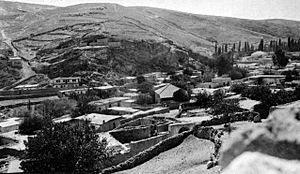 View across Amman to the Citadel |
|||||||
|
|||||||
| Belligerents | |||||||
|
|||||||
| Commanders and leaders | |||||||
| Units involved | |||||||
|
Fourth Army
|
||||||
The Second Battle of Amman was a key fight on September 25, 1918, during World War I. It was part of a larger attack called the Battle of Megiddo in the Sinai and Palestine Campaign. This battle saw the British Empire and their allies, known as the Egyptian Expeditionary Force (EEF), capture the city of Amman from the Ottoman Empire. This victory was important because it cut off a major escape route for Ottoman forces.
Earlier in 1918, the EEF had tried to cross the Jordan River and capture Amman twice, but they failed. This third attempt was successful. The battle helped the Allies win control of a large area and capture many Ottoman soldiers.
Contents
Setting the Scene
Before the Battle of Megiddo began on September 19, 1918, the front line was long and winding. It stretched from the Mediterranean Sea, across the Plain of Sharon, and then over the Judean Hills. It continued all the way to the Dead Sea.
The area held by Chaytor's Force was on the far right side of this line. It included the Jordan Valley, which was overlooked by Ottoman guns.
Amman's Importance
Amman, also known as Philadelphia in ancient times, is a city surrounded by hills. It had important Roman ruins, like an amphitheater. A strong fort, called a citadel, protected the city from the north and west.
The Hejaz railway was very close to Amman. This railway was super important for the Ottoman Fourth Army. It was their main way to get supplies and send reinforcements. It also became their main escape route when they had to retreat.
Getting Ready for Battle
As the main attacks by the EEF began, a strong force was needed to protect their right side in the Jordan Valley. This was to stop any attacks from the Ottoman Fourth Army.
Ottoman Fourth Army
The Ottoman Fourth Army had about 6,000 foot soldiers and 2,000 cavalry. They also had 74 artillery guns. Their leader was General Mohammed Jemal Pasha.
This army was based in Amman and controlled the Jordan Valley. It included several divisions and brigades, like the 48th Infantry Division and the Caucasus Cavalry Brigade.
Chaytor's Force
The Allied force attacking Amman was called Chaytor's Force. It was led by Major General Edward Chaytor. This group was very strong, with about 11,000 soldiers.
It included:
- The ANZAC Mounted Division (from Australia and New Zealand)
- The 20th Indian Brigade (from British India)
- The 1st and 2nd Battalions of the British West Indies Regiment
- The 38th and 39th Battalions of the Royal Fusiliers
- Machine gun units and artillery
By September 21, only the Ottoman Fourth Army was still in position. The other two Ottoman armies were retreating. General Edmund Allenby, the overall EEF commander, decided that destroying the Fourth Army was the next big goal. Chaytor's Force was ordered to move east to capture Es Salt and Amman. They also needed to stop the Ottoman soldiers retreating from the south.
Moving North and East
Chaytor's Force began moving northwards in the Jordan Valley. On September 20, the British West Indies Regiment captured Bakr Ridge. Other units advanced east towards strong Ottoman positions.
By September 21, the Ottoman Seventh and Fourth Armies had started to pull back. Chaytor's troops pushed forward, capturing key areas. On September 22, they took the road from Nablus to Damieh. They also captured the Jisr ed Damieh bridge, which was important for the Ottoman retreat.
After securing the bridge, Chaytor's Force moved east. They attacked and captured the garrisons at Shunet Nimrin and Es Salt. The Ottoman Fourth Army was retreating, but they had a strong group of soldiers defending Amman.
The Battle for Amman
The defenses around Amman had been made much stronger since the first attack in March 1918. There were many forts and machine gun nests. The land around Amman was also difficult, making it a tough place to attack. However, by autumn, the ground was firm, which was good for fast mounted attacks.
Chaytor's mounted rifle and light horse brigades started their attack on Amman at 6:00 AM on September 25. They attacked from different directions, with the New Zealand Mounted Rifles Brigade coming from the northwest and the 2nd Light Horse Brigade from the west.
The New Zealand Mounted Rifles Brigade quickly faced strong Ottoman resistance. The 2nd Light Horse Brigade also met heavy fire from Ottoman guns and machine guns. Despite this, they fought hard and captured many prisoners and machine guns.
The Allied brigades kept pushing forward, supported by their mountain guns. They forced the Ottoman soldiers to fall back to their main defense line. The 1st Light Horse Brigade tried to go around the Ottoman left side towards the railway.
At noon, the Canterbury Mounted Rifles Regiment rode towards Amman but were stopped by hidden machine guns on the Citadel. However, by 1:30 PM, fighting was happening in the streets, and the 5th Light Horse Regiment had entered the southern part of the town.
The Canterbury Mounted Rifles Regiment then attacked the Citadel on foot. By 3:17 PM, the Ottoman resistance was breaking. The Canterbury Mounted Rifles Regiment captured the Citadel, taking 119 prisoners and six machine guns. They had found a way to attack the Turks in the Citadel from the side.
Soon after, other units joined the fight. The 5th Light Horse Regiment hunted down snipers. The Auckland and Wellington Mounted Rifles Regiments pushed towards the Wadi Amman, a valley. There, 1,700 Ottoman prisoners surrendered.
The railway station was captured at 4:39 PM. Many more prisoners, a wireless station, and lots of supplies were taken. The Allied forces used smart tactics, like riding to good spots to fire on the sides of machine gun nests. This helped them overcome all obstacles and win the battle.
After Amman was captured, the 2nd Light Horse Brigade continued east, crossing the Wadi Amman and taking Hill 3039. The 1st Light Horse Brigade moved along the railway north of Amman, capturing guns and hundreds of retreating prisoners.
Chaytor's Force had 139 casualties in the battle: 27 killed, 7 missing, and 105 wounded. The ANZAC Mounted Division had 16 killed and 56 wounded. The 2nd Battalion British West Indies Regiment had 41 casualties. In return, the Allies captured 10,322 prisoners, 57 guns, and 147 machine guns.
What Happened Next
Only the Ottoman Fourth Army's rearguard (the soldiers protecting the retreat) was captured at Amman. Most of the army had already left, following orders from their commander on September 21.
On September 25, Australian planes bombed an Ottoman column north of Amman. They destroyed a railway station, a long train, and supplies, blocking the line. The survivors had to leave their vehicles and escape on foot or horse.
Two days later, on September 27, planes helped the 1st Light Horse Brigade find and attack more Ottoman soldiers. The light horsemen captured 300 prisoners and two machine guns.
Meanwhile, Chaytor's Force in Amman blocked the road and railway. They prepared to stop the Ottoman II Corps, also known as Southern Force, which was retreating north from Ma'an. This large Ottoman force surrendered to the 5th Light Horse Regiment on September 28.
By September 30, Chaytor's Force had captured a total of 10,322 prisoners, 57 guns, 147 machine guns, and many other supplies and vehicles. This victory effectively ended military operations in the area.


